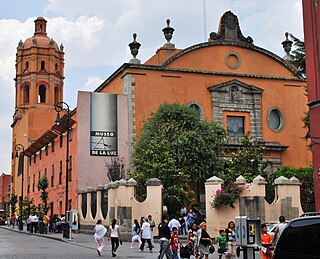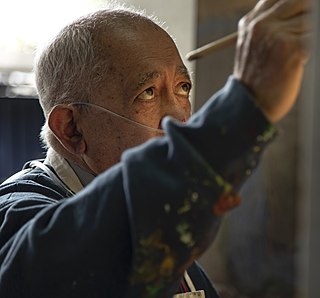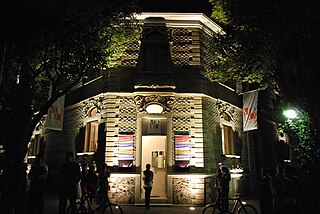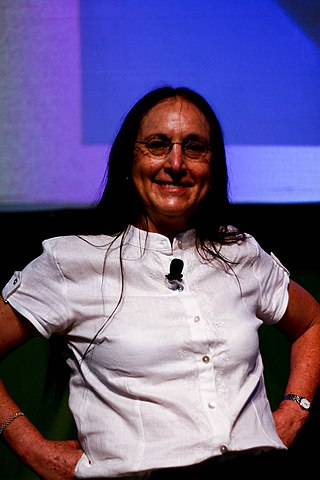
La Raza metro station is a Mexico City Metro transfer station in the Gustavo A. Madero borough of Mexico City. It is a combined underground and at-grade station with two side platforms each, served by Lines 3 and 5. La Raza metro station is located between Potrero and Tlatelolco stations on Line 3, and between Autobuses del Norte and Misterios stations on Line 5. It serves the colonias (neighborhoods) of Vallejo and Héroes de Nacozari. The station's pictogram depicts the nearby Monumento a la Raza, a pyramid-shaped construction erected in honor of la Raza, Mexico's many native peoples and cultures.

The University of the Cloister of Sor Juana is a private university located in the former San Jerónimo Convent in the historic center of Mexico City. This convent is best known for having been the home of Sor Juana Inés de la Cruz for over twenty five years, she produced many of her writings here. After the convent was closed in the 19th century, the large complex was divided and was home to a number of institutions and businesses, including a large dance hall in the mid 20th century. In the 1970s, the government expropriated the complex, explored it and began the restoration process. In 1979, the current university was founded at this site and it is currently the benefactor and guardian of the complex. The institution offers bachelors, two masters and two certificates, mostly in the humanities. The institution also sponsors or co-sponsors a number of cultural and educational activities, mostly situated in the historic center of the city.

Ciudad Universitaria is the main campus of the National Autonomous University of Mexico (UNAM), located in Coyoacán borough in the southern part of Mexico City. Designed by architects Mario Pani and Enrique del Moral, it encloses the Olympic Stadium, about 40 faculties and institutes, the Cultural Center, an ecological reserve, the Central Library, and a few museums. It was built during the 1950s on an ancient solidified lava bed in Coyoacán called "El Pedregal" to replace the scattered buildings in downtown Mexico City where classes were given. It was completed in 1954 at a cost of approximately $25 million. At the time of its completion it was the largest single construction project in Mexico since the Aztecs. It was declared a World Heritage Site by UNESCO in 2007.

The National Museum of Anthropology is a national museum of Mexico. It is the largest and most visited museum in Mexico. Located in the area between Paseo de la Reforma and Mahatma Gandhi Street within Chapultepec Park in Mexico City, the museum contains significant archaeological and anthropological artifacts from Mexico's pre-Columbian heritage, such as the Stone of the Sun and the Aztec Xochipilli statue.

Luis Nishizawa Flores was a Mexican artist known for his landscape work and murals, which often show Japanese and Mexican influence. He began formal training as an artist in 1942 at the height of the Mexican muralism movement but studied other painting styles as well as Japanese art.

Leopoldo Flores was a Mexican artist mostly known for his murals and other monumental works which are concentrated in the city of Toluca, State of Mexico. He was born into a poor family in rural State of Mexico, but his artistic ability was evident early and he was able to attend the Escuela Nacional de Pintura, Escultura y Grabado "La Esmeralda" and receive a scholarship to study in Paris. His best known works are the Cosmovitral a large work in stained glass and the Aratmósfera, a “land art” piece both located in Toluca. The first is used as a symbol for the State of Mexico and the latter dominates the main stadium and the hill behind it at the main campus of the Universidad Autónoma del Estado de México (UAEM). He received a number of recognitions of his work from the State of Mexico and an honorary doctorate from the UAEM, which also founded the Museo Universitario Leopoldo Flores to house and promote his work. Despite advanced Parkinson's disease, until his death Flores was still an active artist.
Santos Balmori Picazo was a Spanish-Mexican painter whose heavily European style was not appreciated by his contemporaries of the Mexican muralism movement, but he had influence with the succeeding Generación de la Ruptura artists. He trained and began his art career in Europe moving later to Mexico City. He became a professor and researcher at the Escuela Nacional de Artes Plásticas training younger artists such as Rodolfo Nieto, Pedro Coronel, Carlos Olachea and Juan Soriano. As a teacher, he did not stop drawing but he did not paint professionally again until after retirement, having a number of exhibitions later in life.
Germán Cueto was a Mexican artist. He was part of the initial wave of artistic activity following the Mexican Revolution. However, his stay in Europe from 1927 to 1932 moved him into more European and more abstract work, especially sculpture. While he had a number of exhibitions in Mexico during his life including a retrospective at the Museo de Arte Moderno in 1965, he did not have the kind of success that many of his contemporaries did as he did not follow the then dominant themes or styles of Mexican muralism movement. His work was considered to be avant-garde and is considered to be the first Mexican abstract artist, creating masks and sculptures of wood, wire, plastic, sheet metal, ceramic, electrical wire and other materials, traditional and non-traditional.

The San Pedro y San Pablo College is a colonial church located in the historical center of Mexico City, Mexico.

Gilberto Aceves Navarro was a Mexican painter and sculptor and a professor at the Escuela Nacional de Artes Plásticas and Academy of San Carlos. There have been more than two hundred individual exhibits of his work, with his murals found in Mexico, Japan and the United States. He received numerous awards for his work including grants as a Creador Artístico of the Sistema Nacional de Creadores de Arte, Premio Nacional de Ciencias y Artes and Bellas Artes Medal from the Instituto Nacional de Bellas Artes.

The Regional Museum of Anthropology and History of Chiapas is the largest museum in Tuxtla Gutiérrez in Chiapas and one of the most important of its kind in Mexico. It primarily consists of two main halls with one dedicated to the state’s Mesoamerican archeology and the other to the history of the state starting from the Spanish conquest. The archeological display focus on the native Zoque and Mayan cities, and the historical displays extend in time until the early 20th century. In addition to its permanent collection, it also has a temporary exhibit hall and auditorium to host events such as book signings, summer classes, conferences and more.

The Museo del Objeto del Objeto, or MODO, is a museum in Mexico City and the first museum in Mexico dedicated to design and communications. It was opened in 2010 based on a collection of commercial packaging, advertising, graphic arts, common devices and many other objects dating back to 1810 collected by Bruno Newman over more than 40 years. The museum is dedicated to the preservation of its collection of more than 30,000 items from two centuries and to the research in the history of design and communications.

Museo Nacional de las Culturas Populares is a museum in Mexico City dedicated to Mexico's ethnic and cultural diversity. This diversity not only includes that of its indigenous peoples, but also those of its regions and socioeconomic strata. It was founded in 1982 by anthropologist Guillermo Bonfil Batalla at a time when the country was accepting and promoting its cultural diversity. The museum does not have a large permanent collection but rather focuses on temporary exhibits, concerts, workshops and other cultural and educational events as well as promoting the creation of museums in Mexico to promote local cultures. The museum is also home to the Centro de Información y Documentación Alberto Beltrán, founded in 1971 to promote research and knowledge about Mexican handcrafts and folk art and indigenous ethnicities.

Hector Garcia Cobo was a Mexican photographer and photojournalist who had a sixty-year career chronicling Mexico's social classes, Mexico City and various events of the 20th century, such as the 1968 student uprising. He was born poor but discovered photography in his teens and early 20s, deciding to study it seriously after his attempt to photograph the death of a coworker failed. He was sent to the Academia Mexicana de Artes y Ciencias Cinematográficas by magazine director Edmundo Valdés who recognized García's talent. Most of García's career was related to photojournalism, working with publications both inside and outside of Mexico. However, a substantial amount of his work had more artistic and critical qualities. Many of these were exhibited in galleries and museums, with sixty five individual exhibitions during his lifetime. This not only included portraits of artists and intellectuals but also portraits of common and poor people. He was also the first photojournalist to explicitly criticize Mexico's elite, either making fun of them or contrasting them to the very poor.
Eliana Menassé is a Mexican painter and member of the Salón de la Plástica Mexicana, an honor society for Mexican artists.

The Museum of Light is a science museum dedicated to the phenomena of light, located in the former San Ildefonso College in the historic center of Mexico City. It was opened in 1996 originally in the former church of the San Pedro y San Pablo College. However, this building was closed in 2010 in order to convert it into the Museum of the Constitutions. The Museum of Light was moved to its current and larger location, but it remains an extension of the Universum museum, the general science museum of the Universidad Nacional Autónoma de México.

Pedro Miguel de Cervantes Salvadores was a Mexican sculptor who exhibited in Mexico and abroad and created large monumental works for various locations in the country. Some of his work is noted for its use of used materials such as automobile parts from junkyards. Cervantes received various recognitions for his work including Premio Nacional de Ciencias y Artes in 2011 as well as membership in the Academia de Artes and the Salón de la Plástica Mexicana.

The Elder Museum of Science and Technology is a museum in Las Palmas, the capital city of Gran Canaria in the Canary Islands.

Julieta Norma Fierro Gossman, better known as Julieta Fierro, is a Mexican astrophysicist and science communicator. She is a full researcher at the Institute of Astronomy and professor of the Sciences Faculty at the National Autonomous University of Mexico (UNAM). She is part of the Researchers National System in Mexico, holding a level III position. Since 2004 she is a member of the Mexican Academy of Language.

Julia Tagüeña Parga is a Mexican physicist from the School of Science at the National Autonomous University of Mexico (UNAM) and Doctor of Science from the University of Oxford.






















